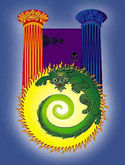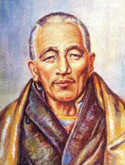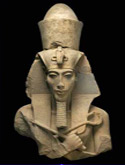I have been perplexing over the question of the use of the tropical over the sidereal zodiac in casting astrology charts. In Solar Fire there is a Djwhal Khul setting under sidereal that is approximately 4 degrees different than the Fagan-Allen setting. I can grasp the use of the tropical zodiac for the unevolved person but for a disciple or initiate would not the sidereal zodiac be more appropriate and why the 4 degrees difference in the two above mentioned sidereal systems?
NN: Here follow some thoughts on the matter;
It is a fact that the constellations in the zodiacal belt are not of equal length or size, and sometimes they even overlap. This is the case with the constellations Pisces and Aquarius for example. Therefore, just by looking at the heavens, it is not so easy to say exactly where one constellation begin and another one end.
In the spirit of equality, and to simplify things all constellations are instead given an equal 30 degrees making a total of 360 degrees of the circle. This is fine, but then comes the next question; where does this circle of 12 equals have its beginning? Maybe zero degrees Aries–but where is zero degrees Aries found in the heavens?
This is where the different sidereal zodiacs differ. They all have more or less different beginning points, or anchoring points in the heavens. Certain stars may indicate the beginning points, but these stars are also in dispute, hence the different beginning-points.
The Tibetan gave the year 2117 as year of the beginning of the Aquarian Age, and based upon this year can be calculated a sidereal zodiac, because at that time (by most definitions) the vernal equinox will be 30 degrees off from beginning of Pisces. It is an assumption that when he gave the year 2117, he meant that the vernal equinox would be displaced by 30 degrees from its archetypal position at zero degrees Aries on the anti-clockwise wheel, and zero degrees Pisces on the clockwise wheel.
So the sidereal zodiac can in a way be considered as factual, because there is no great displacement of planetary positions with respect to the constellations in the background. The planets are usually seen against the backdrop of the constellation that they are said to ‘be in’. But the problem is to know where the circle of constellations begin.
The tropical zodiac does not have the same problem. We know exactly where it begins, although its beginning-point is moving approximately 1 degree every 72 years in relation to the background stars. We still know exactly where it is in relation to the background stars and constellations.
The different sidereal zodiacs are measured with respect to the tropical zodiac and it’s beginning-point–the vernal point. The difference or displacement between the two is called the ayanamsha. Most ayanamshas these days are around 25 degrees, whereas DK’s ayanamsha is around 28 degrees. You can calculate this exactly in Solar Fire, by noting the difference when using the different ayanamshas.
Contrasting the two zodiacs:
Generally, the sidereal zodiac is more lunar, and along the hard-line rays; 1, 3, 5, 7. The tropical zodiac is more solar, and related to the soft-line rays; 2, 4, 6. It is no surprise that a country like India, influenced by Rays 1 and 3 and signs (or should I say constellations) Capricorn and Aries is so much involved with the sidereal zodiac. It is a ‘lunar’ nation, and hence maybe it’s inhabitants will thereby respond more to the sidereal zodiacs than the tropical one, as they are envoloped by that thought-form. If it’s a Moon chain Ego, then maybe the sidereal will have greater influence as well. We also have to consider the races and sub-races in the same manner as we do with nations and maybe continents. The individual ray make-up may have to be considered too. This may be one of the reasons why DK tells us to determine the ray before interpreting the chart. Also the focal centre of the chakras for a certain incarnation may also have to be taken into consideration.
The two different zodiacs are always operative to some extent, and always have an influence, its just a question of determining the ratio and percentage of influence.
Listing factors that may be involved in determining the influences of the two zodiacs:
Evolutionary status.
Mechanism of response.
Race, sub-race, nation and continent.
Where individualisation occurred.
Individual ray make-up.
Focal centre.
Gender.
We must understand that besides considering the different zodiacs, we find certain techniques or systems applied with the zodiacs. These systems in themselves may be more material or more subjective in their orientation. So it’s not cut and dry, but a mix depending on matters applied with the zodiacs.
But again, in general, I would say that sidereal is more form oriented; tropical more responsive to soul; whereas esoteric astrology more definitely unfold the inner life and bring in the remoter possibilities. Only as a man re-orients himself and begins to travel back to his source is it possible for esoteric astrology to become more influential than the other systems.
Why I mention esoteric astrology here, is because I believe that it is inclusive of both perspectives and approaches of the Tropical and Sidereal zodiacs. Esoteric astrology contains both, yet transcends the limitations of both. Triangulation is achieved, and the polar opposites are being resolved.
After the Path of Discipleship the sidereal zodiac, esoterically applied, will begin to supersede the influences of the tropical zodiac. You might say that, the sidereal zodiacs are stronger in the 1st and 3rd decanates of form and spirit, whereas tropical govern the 2nd or middle decanate.
Maybe I can express the influences as follows:
1st decanate of form control and personality integration – Tropical rise, Sidereal/Houses culminate, Sidereal/Esoteric anti-culminate.
2nd decanate of Discipleship – Tropical culminates, Sidereal/Houses set, Sidereal/Esoteric rise.
3rd decanate of Initiate – Tropical set, Sidereal/Houses anti-culminate, Sidereal/Esoteric culminate.
As we take the first Sirian initiation (our third initiation), our scope becomes widened and more planetary and we can begin to respond to the stars and constellations in a new and more direct manner. At the third initiation we start understanding and accessing the first aspect in a new and more direct way. We are solarized as it were–we have seen the culmination of the tropical zodiac which is now approaching the western horizon. The tropical zodiac have served its purpose, but is now beginning to be a limitation, just like the causal body have to be destroyed, because it has become a limitation.
Then there is of course the question of Heliocentricity. The Heliocentric perspective is suited for the astrology that deals with inter-solar systemic astrology. That astrology which seeks to find out what is going on between our solar system and other solar systems, especially within the Sirian System of Suns. It deals more with connections to, and within, organisations and organisms, as these are composed of many parts or entities, put together as one whole. How ones individual gifts can assist the whole, and how that whole impress the individual part with something greater and far-reaching, offering transcendence of the individual ring-pass-not.














